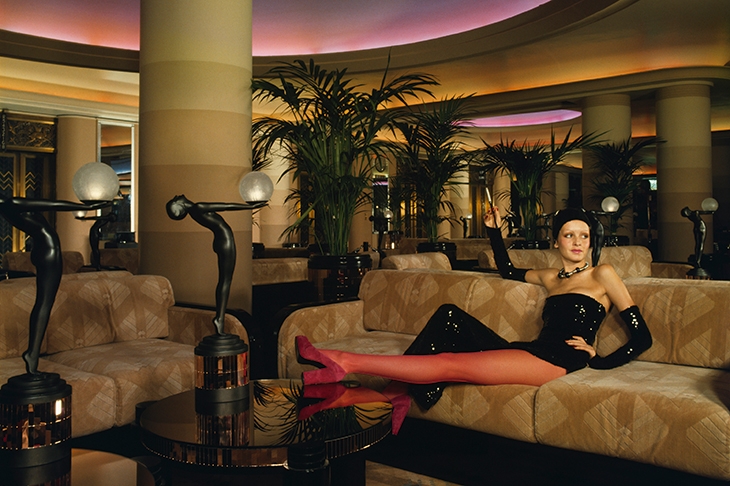On 10 September 1973 the 1930s Kensington High Street department store formerly known as Derry & Toms reopened as Big Biba. It sold the dress designer Barbara Hulanicki’s distinctive look in furniture, paints and wallpaper, sports equipment and food, as well as her familiar fast fashion. If you had to define that aesthetic then, you’d have said it was campy and kitschy. But above all you’d have said it was deco, an increasingly familiar word for the between-wars moderne style in everything from buildings to jewellery.
Derry & Toms itself was a 1933 moderne temple of commerce, slathered in stylised ironwork and bas-reliefs. It had a ‘Rainbow Room’ upstairs, which looked like a 1930s cinema crossed with an ocean-liner ballroom, and the largest roof garden in Europe above it. The new Biba furnishings and the packaging in that Biba food hall were all 1930s-inflected, pastiche deco.
And here’s Twiggy, photographed by Justin de Villeneuve in Big Biba that year, in what in the early 1970s would have been called a ‘divine decadence’ pose, following the famous strapline for Cabaret, the hit film musical of 1972 based on Isherwood’s Goodbye to Berlin. She’s wearing a black beaded dress, a bandeau and clutches a long cigarette-holder. Behind her are potted palms and bronzed light fittings in the manner of Chiparus’s and Preiss’s exultant women. Above her is the Rainbow Room’s curvilinear ceiling with the concealed lighting turned up to mauve. (It was a familiar look for Twiggy; in 1971 she’d played Polly Browne in Ken Russell’s film version of The Boyfriend, a 1950s stage pastiche of a 1920s film musical. A revival of a revival.)
Fifty years ago, the art and design historian Bevis Hillier named and explained art deco in a new kind of art book. Deco was the interwar style whose 1960s revival was becoming a dominant design influence in everything from smart movie settings to graphics, architecture and interiors. Hillier hadn’t exactly invented the term, it was what fashionable young art- and design-land people were using. People such as the Kensington Church Street antique dealer John Jesse, the pioneer art-nouveau dealer who had moved on a couple of decades in 1965 from selling 1890s Gallé and Tiffany to between-wars Daum crystal and Puiforcat silver — the expensive tchotchkes of the interwar rich — to his film and popstar clients.
What Hillier did, in that crucial Studio Vista paperback of 1968, with its bold orange cover designed in pastiche deco by Barry Zaid, was to pull it all together. He made people look around them at Western Avenue factories and suburban cinemas, and at their grannies’ brightly coloured Clarice Cliff teasets and Czech glass in the later Lalique manner.
And then he went on to point to the deco revival he saw everywhere from 1965 onwards — in broadsheet colour-supplement fashion and interiors spreads, in John Jesse selling and Martin Battersby collecting antiques of the 1920s and 1930s (both men were previously high priests of art nouveau). RCA students, so he said, were thumbing through ancient copies of Vogue in the V&A. A market was being created at several levels, from the big auction houses to Portobello Road. It ‘felt like a cult at the beginning’, John Jesse told me recently. And then there was Bonnie and Clyde (1967). According to Hillier, deco had even influenced pop art.
The art historians’ creation myth is that art deco coalesced in the spectacular Paris Exposition International des Arts Décoratifs in 1925. There was a vision fully realised in pavilions and room sets offering a completely new show-off style for the pre-crash rich. The influences, according to Hillier, ranged from the speedy imagery of new technology — passenger planes and fast cars — to the artistic revolutions of the previous two decades — cubism, expressionism, futurism, vorticism and the Ballets Russes designs — to the fashionable discovery of American Indian art — the Aztecs and the Incas and their skyscraper-like stepped buildings.
Hillier explained, with pictures set in text, rather than art-history book clumps, how the style had moved from luxury — Paris artist-craftsmen working in rare woods and precious metals — to peoples’ palaces like department stores and super-cinemas; from Cartier to costume jewellery and early plastics; from the Roaring Twenties to the fascistic Thirties. And from Europe to Hollywood, where set and costume designers ran with deco themes of glamorous modern escapism for Great Depression audiences such as in Busby Berkeley’s 42nd Street of 1933.
Hillier followed the characteristic deco motifs — the fountain in the 1920s, the sun ray in the 1930s — through from high art and ethnic tradition to two-tone shoes and suburban garden gates. Art deco, he said, ‘had its Jekyll and Hyde aspects. On the one hand, there were new, revolutionary and often refined designs, on the other… kitsch. Most of the bungaloid houses and mannered cinema designs of the 1930s are far removed from the ideals of Gropius, Le Corbusier et al…’
But deco never was modernism (even if it had taken some of its hard lines). Purist Bauhausers hated it, thought it vulgar and derivative. It was moderne, decorative, glamorous, sexy and fun, never doctrinaire. It never had manifestos, never had an Adolf Loos. Albert Speer and his triumphalist work for Hitler was a million miles from, say, Claridge’s mirrored foyer of 1929. There’s little enough of either full-on deco or modernism in this country and the same buildings — typically curvy white seaside villas — have been claimed for both in different decades.
Three years after Art Deco’s publication in the UK and the US, in 1971, the Minneapolis Institute of Arts put on a spectacular art deco exhibition with Hillier as the lead curator. In his introduction to the catalogue he admitted that he hadn’t got the half of it in 1968 because he hadn’t seen the spectacular American examples — the Chrysler Building or Radio City Music Hall — nor seen just how far the revival could go. He didn’t know then that Roxy Music and David Bowie, art-school musicians with an acute sense of costume and staging and every kind of design reference, were just two years round the corner. And there was a raft of big films with stylised deco backgrounds, starting with Cabaret, still to come.
The great deco revival decade from, let’s say, 1965 to 1975 seemed to end completely with the look of punk — its clothes and graphics and council-block imagery — feeling like a sharp red line drawn underneath it. But in the early 1980s, when the money came back to London, so did something of deco in the high-style music videos, and postmodern architecture, with its pointless pediments and giant arched windows everywhere — an obvious deco legacy.
Hillier became a star of a new kind of art and design criticism: accessible, wide-ranging from high art to mass culture, funny and smart, but without the Big Theory clutter of his French and Italian contemporaries. He went on to trace how decorative arts changed from the 1940s to the 1950s in the brilliant Austerity Binge. And then he devoted the next 25 years to a hugely popular British artist, John Betjeman, producing three volumes of biography. And by example he helped make a new generation of British design writers like Stephen Bayley and Deyan Sudjic employable.
And, for me, going back to my deco books inevitably leads to Tamara de Lempicka, that most definitive and commercial deco portrait painter. I’m looking at her ‘Unfinished portrait of Tadeusz de Lempicki’ of 1928. Her husband. He’s in a big black double-breasted coat with a big white scarf, and a skyscraper in the background — a nod to Marinetti’s futurism. It’s obviously got to be my Christmas 2018 get-up.





Comments